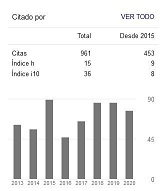Contents of Some Essential Minerals in Forages for Ruminants in Adama, Ethiopia. A Case Study.
Resumen
The contents of phosphorous (P), calcium (Ca), sulphur (S), manganese (Mg), sodium (Na), potassium (K), iron (Fe), and copper (Cu), in graminaceae and legumes used for ruminant nutrition in the city of Adama, Eth i-opia, were determined. The samples were taken at random, from grazing areas near the city, and in the food market for these animals. The Molibdovanate method was used to determine P ; Ca,Mg and Cu were determined by the atomic adsorption spectroscopic met hod with flame; Na and K were determined by flame photo-metry; and S, by the turbidimetric method. The values were compared with the values reported for these animal requirements. Deficiencies of Cu, P and Na were found in all the samples analyzed. King Grass, wheat and teff stalks, important sources of nutrients du ring the dry season, were the scarcest. Statistics (P < 0.05) showed that, as a group, graminaceae were more mineral deficient than legumes. A study of certain mineral sources from the area is recommended for use as raw materials for salt production.Descargas
Citas
AOAC (1995). Official Methods of Analysis (16th edition). Washington, DC: Association of Official Analytical Chemist.
FAO (2008). Guide to Laboratory Establishment for Plant Nutrient Analysis. Fertilizer and Plant Nutrition Bulletin, 9, 40-81. Rome: Food and Agriculture Organization of the United Nations (FAO).
KABAIJA, E. y LITTLE, D. A. (2012). Nutrient Quality of Forages in Ethiopia with Particular Reference to Mineral Elements. Extraído en dicembre de 2012, desde www.fao.org/wairdocs/ILRI/x549E/x5491e18.htm.
MARTÍNEZ, S.; GUEVARA, R.; CURBELO, L.; PEDRAZA, R. e HIDALGO, D. (2007). Contenidos minerales de pastos más utilizados por rebaños vacunos lecheros al oeste de la ciudad de Camagüey, Cuba. Rev. prod. anim., 19 (2), 2007.
MCDOWELL, L. R.; VELÁSQUEZ-PEREIRA, J. y VALLE, G. (1997). Minerals for Grazing Ruminant in Tropical Regions. Gainesville, EUA: Department of Zootechnics, Centre of Tropical Agricultura, University of Florida.
SUTTLE, N. F. (2010). Mineral nutrion of livestock. UK: Pentland Science Park. Extraído en abril de 2014, desde www.ucv.ve/fileadmin/.../Minerals_inAnimal Nutrition.pdf.
TILAHUN, S.; VIJCHULATA, S.; CHAIRATANAYUTH, P. y SWASDIPHANICH, S. (2007). Effects of Natural Mineral Soils on Body Weight and Liver Minerals of Black Head Somali Sheep in Ethiopia. Kasetsart J. (Nat. Sci.), 41, 288-299.
TOLERA, A. (2008). Feed resources and feeding management. Addis Ababa, Ethiopia: Ethiopia Sanitary and phytosanitary Standards and Livestock and Meat Marketing Program (SPS-LMM).
YEMI, A. (2008). Nutrition and Feeding of sheep and Goats. In Sheep and Goat Production Handbook. Ethiopia. Extraído en abril 2013, desde www.esgpip.com/Handbook/chapter7.html.
Los autores de los artículos publicados en RPA retienen los derechos de autor de su trabajo, de marca y patente, y también sobre cualquier proceso o procedimiento descrito en el artículo, así como a compartir, copiar, distribuir, ejecutar y comunicar públicamente el artículo publicado en la RPA o cualquier parte de aquel siempre que indiquen la fuente de publicación (autores del trabajo, revista, volumen, número y fecha), pero están de acuerdo en que la revista publique los trabajos bajo una licencia Creative Commons.
![]() Licencia Attribution-NonCommercial 4.0 International (CC BY-NC 4.0)
Licencia Attribution-NonCommercial 4.0 International (CC BY-NC 4.0)






































